Nonlinear Pushover Analysis of Retrofitted Transmission Towers Under Static Wind Loads
Abstract
1. Introduction
- (a)
- Investigating the effects of six retrofit methods on the capacity of whole tower structures subjected to static wind loading through nonlinear pushover analysis.
- (b)
- Investigating the effects of different retrofit methods on the tower capacity under different wind directions.
- (c)
- Comparing the capacity, stiffness, and ductility between non-retrofitted and retrofitted towers to demonstrate the efficiency of the retrofit method, and suggesting the most suitable retrofit method for the considered tower.
2. Static Wind Loading Acting on Transmission Towers
- q0 is the dynamic reference wind pressure (N/m2), given by
3. Finite Element Modeling of Non-Retrofitted Towers Using Nonlinear Pushover Analysis
3.1. Nonlinear Pushover Analysis
3.2. Finite Element Modeling Procedure
3.3. Finite Element Modeling Results
4. Finite Element Modeling of Retrofitted Towers Using Nonlinear Pushover Analysis
5. Results and Discussion
6. Conclusions
Author Contributions
Funding
Data Availability Statement
Conflicts of Interest
References
- Albermani, F.; Mahendran, M.; Kitipornchai, S. Upgrading of transmission towers using a diaphragm bracing system. Eng. Struct. 2004, 26, 735–744. [Google Scholar] [CrossRef]
- Xie, Q.; Sun, L. Failure mechanism and retrofitting strategy of transmission tower structures under ice load. J. Constr. Steel Res. 2012, 74, 26–36. [Google Scholar] [CrossRef]
- Qiang, X.L.; Jian, Z. Experimental study on failure modes and retrofitting method of latticed transmission tower. Eng. Struct. 2021, 226, 111365. [Google Scholar]
- Balagopal, R.; Rao, N.P.; Rokade, R.P.; Umesha, P.K. Recent Advances in Structural Engineering. Volume 2. Lect. Notes Civ. Eng. 2019, 12, 639–648. [Google Scholar]
- Li, J.; Wu, X.; Yang, B.; Wang, J.; Sun, Q. Experimental Study and Bearing Capacity Analysis of Retrofitted Built-Up Steel Angle Members under Axial Compression. Appl. Sci. 2023, 13, 9280. [Google Scholar] [CrossRef]
- Patrick, R.M.; Mark, D.D. Compression strength of reinforced steel angles. Eng. Struct. 2024, 306, 117875. [Google Scholar]
- Yan, Z.; Julie, E.M.; Xing, M. Modeling of steel lattice tower angle legs reinforced for increased load capacity. Eng. Struct. 2012, 43, 160–168. [Google Scholar]
- Li, S.; Marco, T.; Bozidar, S. In-situ retrofit strategy for transmission tower structure members using lightweight steel casings. Eng. Struct. 2020, 206, 110171. [Google Scholar]
- Liang, G.; Wang, L.; Liu, Y.; Geng, N. Mechanical behavior of steel transmission tower legs reinforced with innovative clamp under eccentric compression. Eng. Struct. 2022, 258, 114101. [Google Scholar] [CrossRef]
- Liu, C.C.; Yan, Z.; Jiang, T.; Guo, T.; Zou, Y.B. Experimental study on failure modes of a transmission tower reinforced with clamps. Eng. Fail. Anal. 2024, 159, 108151. [Google Scholar] [CrossRef]
- Guo, X.; Zong, S.; Shen, Z.; Zhu, S.; Yuan, S. Mechanical behavior of in-service axial compression angle steel members strengthened by welding. J. Build. Eng. 2020, 32, 101736. [Google Scholar] [CrossRef]
- Gorripotu, K.; Raghavan, R. Failure intervention of transmission line tower primary legs using bi-angled cruciform retrofitting. Eng. Fail. Anal. 2025, 167, 108970. [Google Scholar]
- Cai, Y.; Xie, Q.; Xue, S.; Hu, L.; Kareem, A. Fragility modelling framework for transmission line towers under winds. Eng. Struct. 2019, 191, 686–697. [Google Scholar] [CrossRef]
- Xue, J.; Mohammadi, F.; Li, X.; Ardakani, M.S.; Ou, G.; Pu, Z. Impact of transmission tower-line interaction to the bulk power system during hurricane. Reliab. Eng. Syst. 2020, 203, 107079. [Google Scholar] [CrossRef]
- Fu, X.; Li, H.N.; Li, T.; Wang, J.; Hu, C. Fragility Analysis of Transmission Line Subjected to Wind Loading. J. Perform. Constr. Facil. 2019, 33, 04019044. [Google Scholar] [CrossRef]
- Li, T.; Zhang, X.; Fu, X. Fragility analysis of a long-span transmission tower–line system under wind loads. Adv. Struct. Eng. 2020, 23, 2110–2120. [Google Scholar]
- Wang, D.; Li, S.; Sun, C.; Huang, G.; Yang, Q. Assessment of wind-induced fragility of transmission towers under quasi-static wind load. Wind. Struct. An Int. J. 2021, 22, 343–352. [Google Scholar]
- Liu, C.; Yan, Z. Fragility Analysis of Wind-Induced Collapse of a Transmission Tower Considering Corrosion. Buildings 2022, 12, 1500. [Google Scholar] [CrossRef]
- Wang, J.; Li, H.N.; Fu, X.; Dong, Z.Q.; Sun, Z.G. Wind fragility assessment and sensitivity analysis for a transmission tower-line system. J. Wind. Eng. Ind. Aerodyn. 2022, 231, 105233. [Google Scholar] [CrossRef]
- Zhu, C.; Yang, Q.; Huang, G.; Zhang, X.; Wang, D. Fragility analysis and wind directionality-based failure probability evaluation of transmission tower under strong winds. J. Wind. Eng. Ind. Aerodyn. 2024, 246, 105668. [Google Scholar] [CrossRef]
- IEC 60826:2017 standard; Overhead Transmission Lines–Design Criteria. International Electrotechnical Commission: Geneva, Switzerland, 2017.
- Mara, T.G.; Hong, H.P. Effect of wind direction on the response and capacity surface of a transmission tower. Eng. Struct. 2013, 57, 493–501. [Google Scholar] [CrossRef]
- Fu, X.; Li, H.N. Uncertainty analysis of the strength capacity and failure path for a transmission tower under a wind load. J. Wind. Eng. Ind. Aerodyn. 2018, 173, 147–155. [Google Scholar] [CrossRef]
- Tapia, H.E.; Emilio, S. Structural behaviour of lattice transmission towers subjected to wind load. Struct. Infrastruct. Eng. 2017, 13, 1462–1475. [Google Scholar]
- Powell, G.; Simons, J. Improved Iterative Strategy for Nonlinear Structures. Int. J. Num. Meth. Eng. 1981, 17, 1455–1467. [Google Scholar] [CrossRef]
- Crisfield, M.A. A Fast Incremental/Iteration Solution Procedure that Handles ‘Snap-Through’. Comput Struct. 1981, 13, 55–62. [Google Scholar] [CrossRef]
- ABAQUS; version 6.14; Dassault Systems: Vélizy-Villacoublay, France, 2020.
- Fu, X.; Wang, J.; Li, H.N.; Li, J.X.; Yang, L.D. Full-scale test and its numerical simulation of a transmission tower under extreme wind loads. J. Wind. Eng. Ind. Aerodyn. 2019, 190, 119–133. [Google Scholar] [CrossRef]
- Vettoretto, G.; Li, Z.; Affolter, C. Evaluation of the Ultimate Collapse Load of a High-Voltage Transmission Tower under Excessive Wind Loads. Buildings 2023, 13, 513. [Google Scholar] [CrossRef]
- Zhu, Y.; Zhang, X.; Xie, Q. Ultimate capacity analysis of transmission tower line system under wind load. IOP Conf. Ser. Earth Environ. Sci. 2021, 787, 012012. [Google Scholar] [CrossRef]
- Wang, J.; Li, H.N.; Fu, X.; Li, Q. Geometric imperfections and ultimate capacity analysis of a steel lattice transmission tower. J. Constr. Steel Res. 2021, 18, 106734. [Google Scholar] [CrossRef]
- Li, J.; Gao, F.; Wang, L.; Ren, L.; Liu, C.; Yang, A.; Yan, Z.; Jiang, T.; Li, C. Collapse Mechanism of Transmission Tower Subjected to Strong Wind Load and Dynamic Response of Tower-Line System. Energies 2022, 15, 3925. [Google Scholar] [CrossRef]
- Kim, P.; Han, W.S.; Kim, H.; Kim, J.H.; Kang, Y.J.; Kim, S. Experimental validation of a simplified structural design for lattice transmission towers. J. Constr. Steel Res. 2025, 226, 109291. [Google Scholar] [CrossRef]
- Zhang, J.; Xie, Q. Failure analysis of transmission tower subjected to strong wind load. J. Constr. Steel Res. 2019, 160, 271–279. [Google Scholar] [CrossRef]
- Song, H.; Li, Y. Dynamic Response Modeling of Mountain Transmission Tower-Line Coupling System under Wind–Ice Load. Buildings 2023, 13, 828. [Google Scholar] [CrossRef]
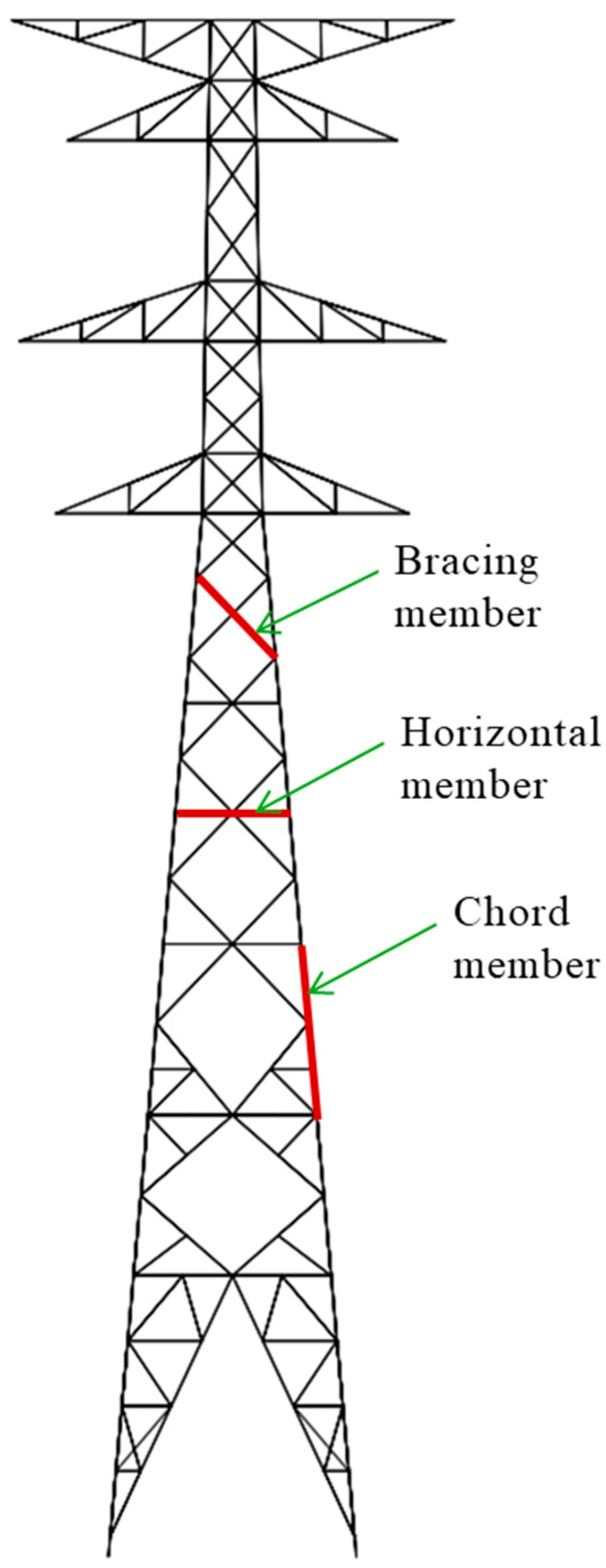
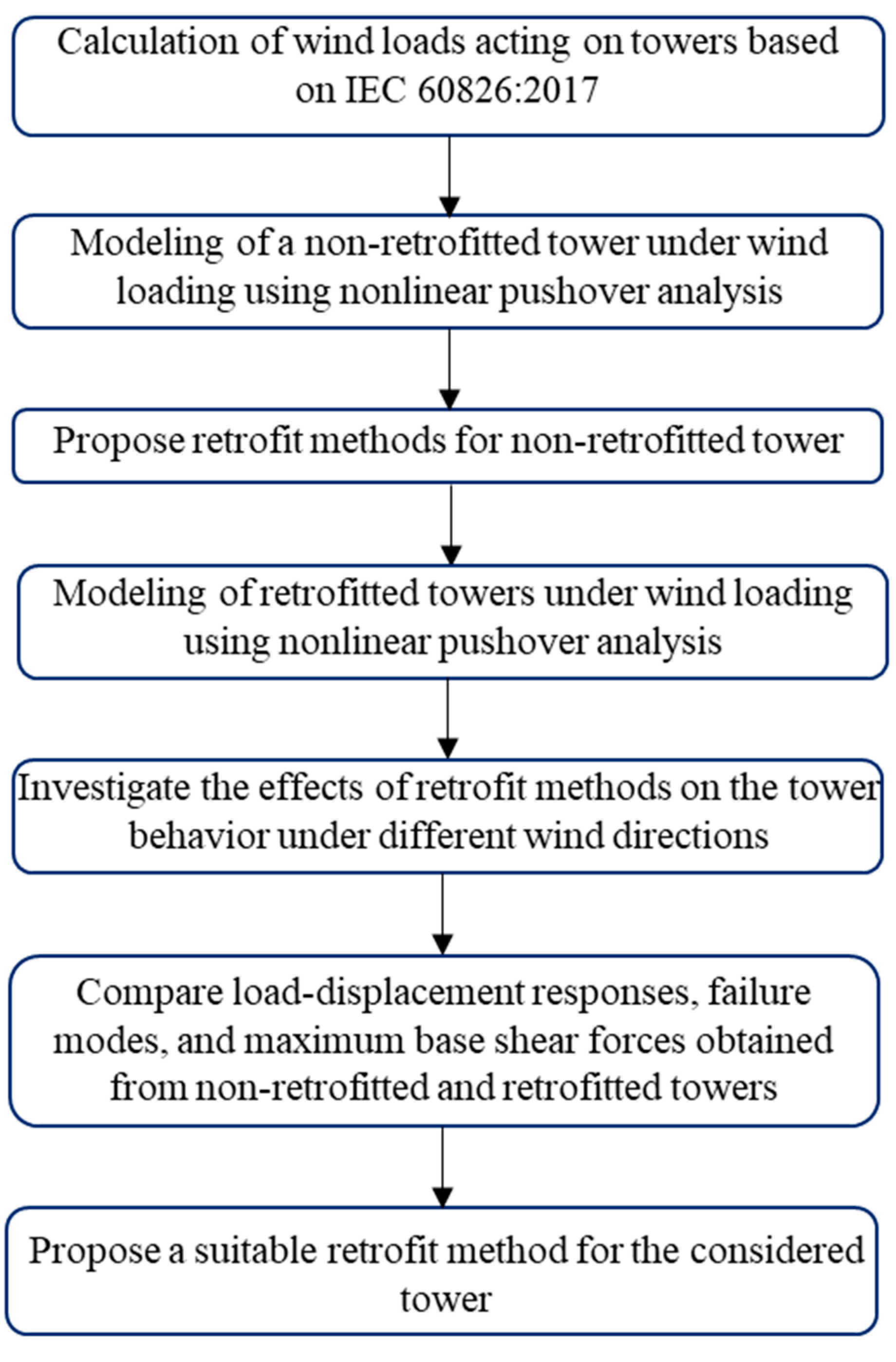
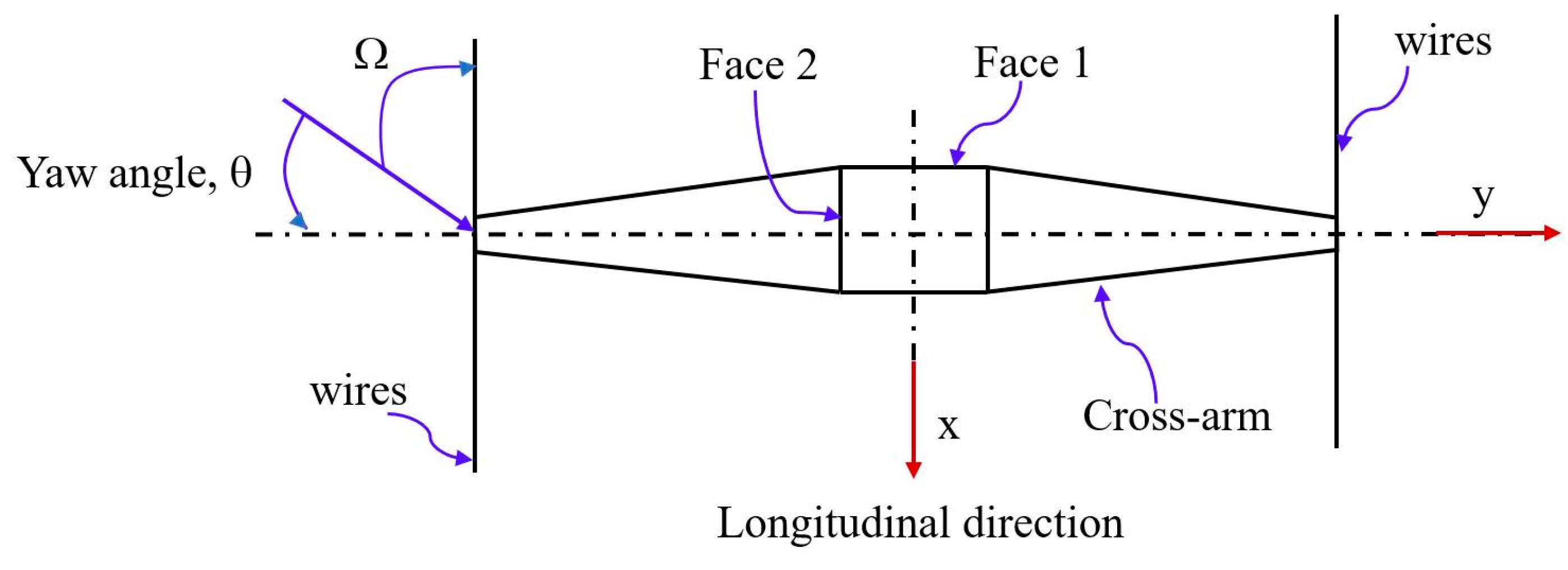
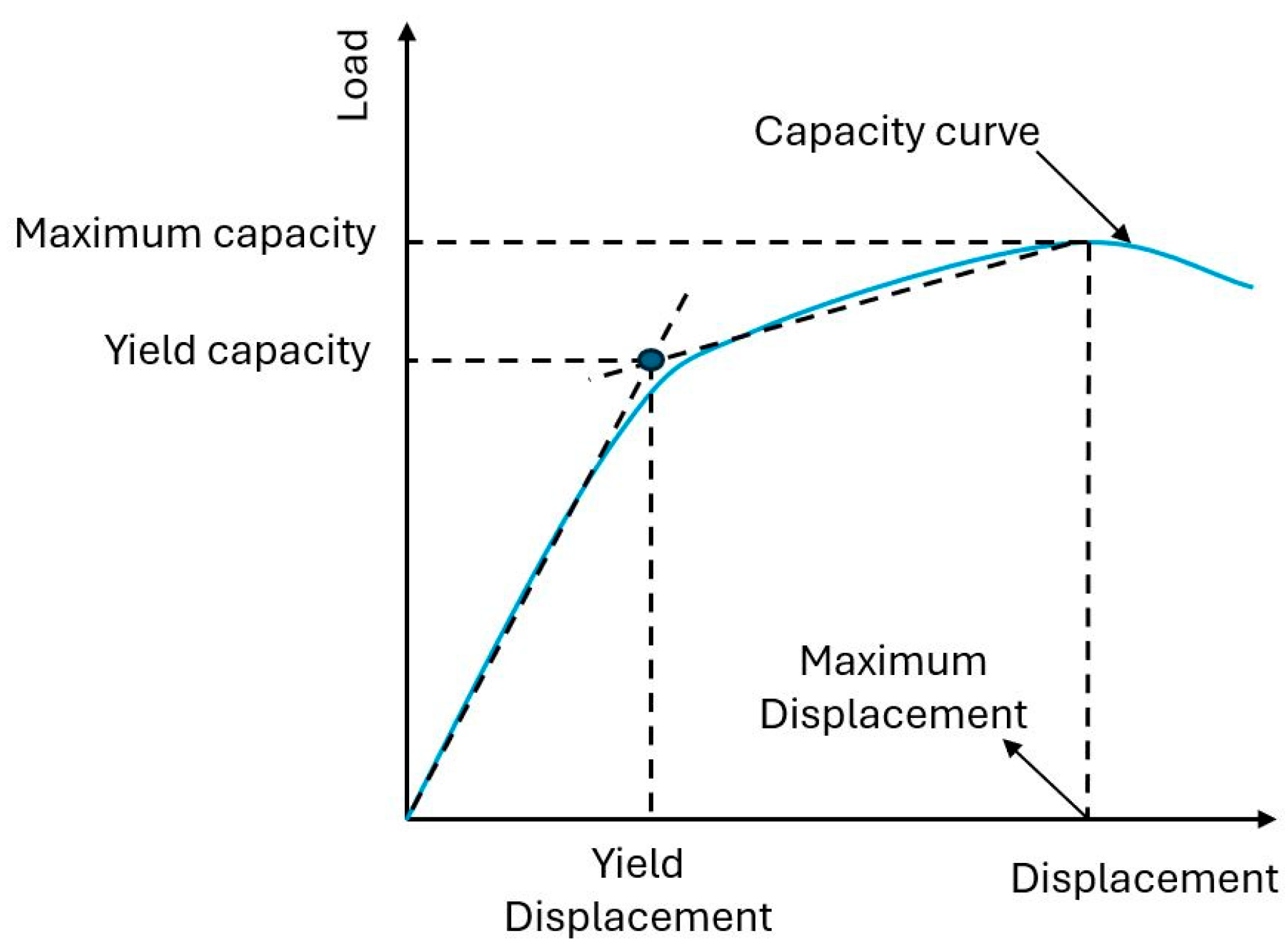
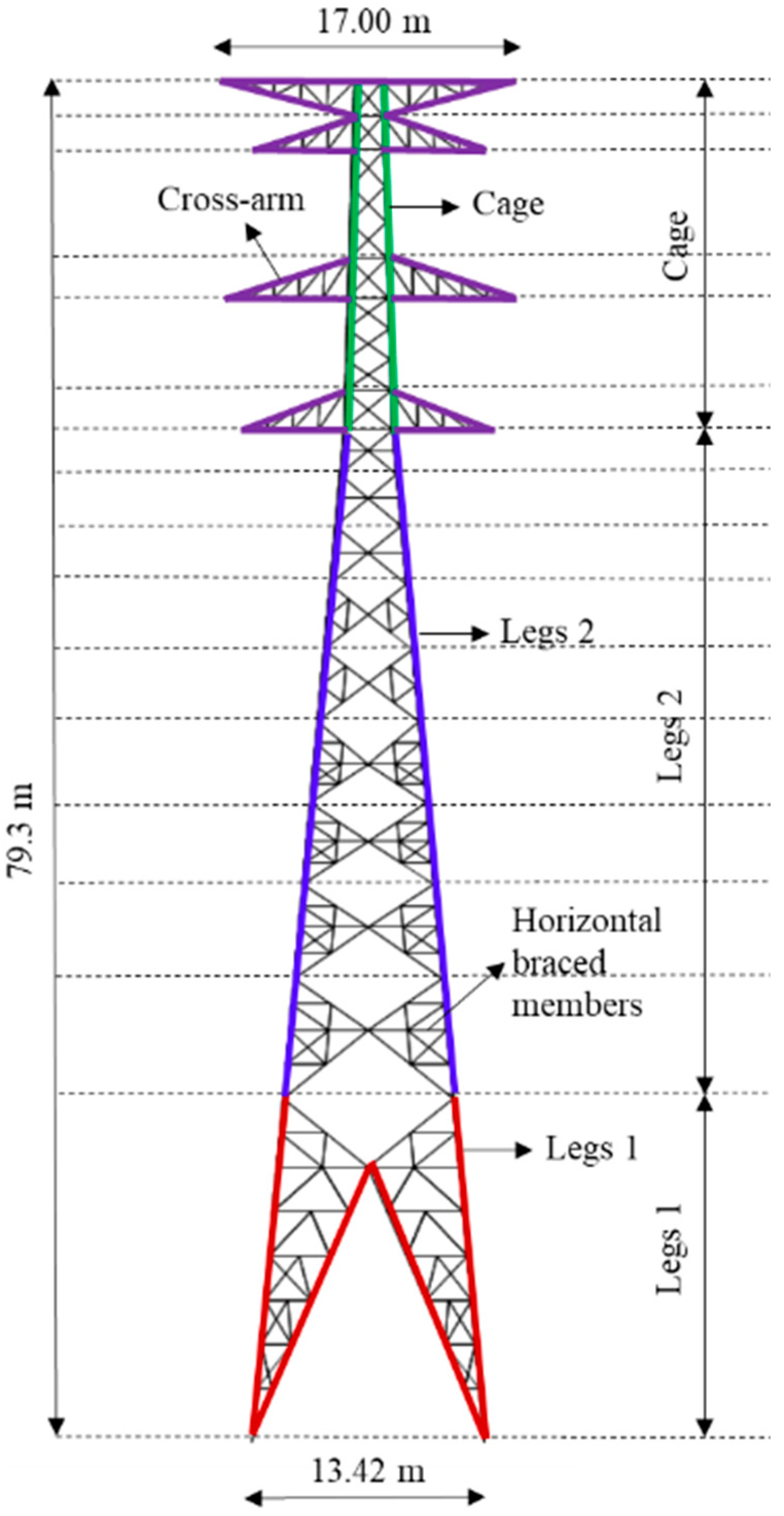
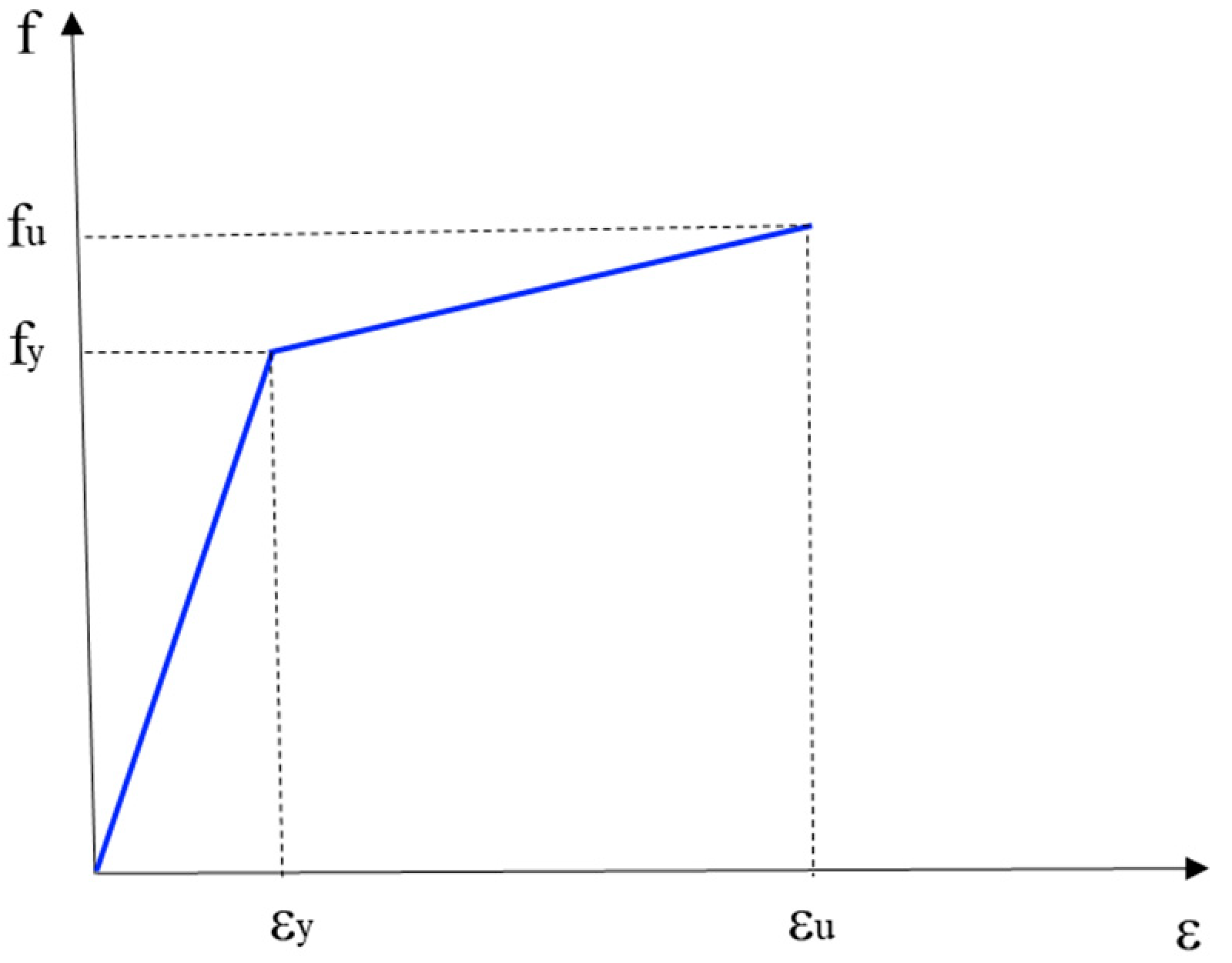

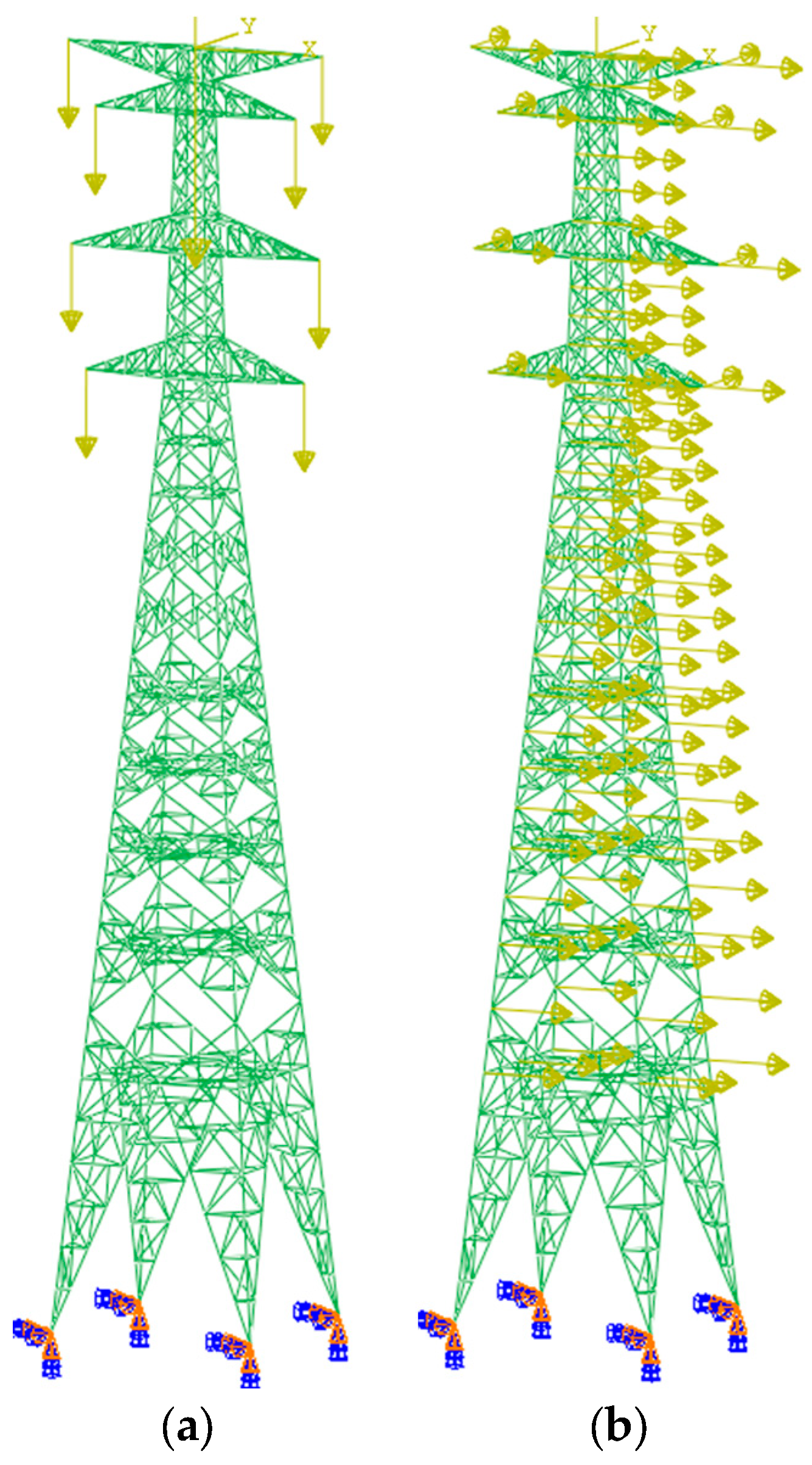
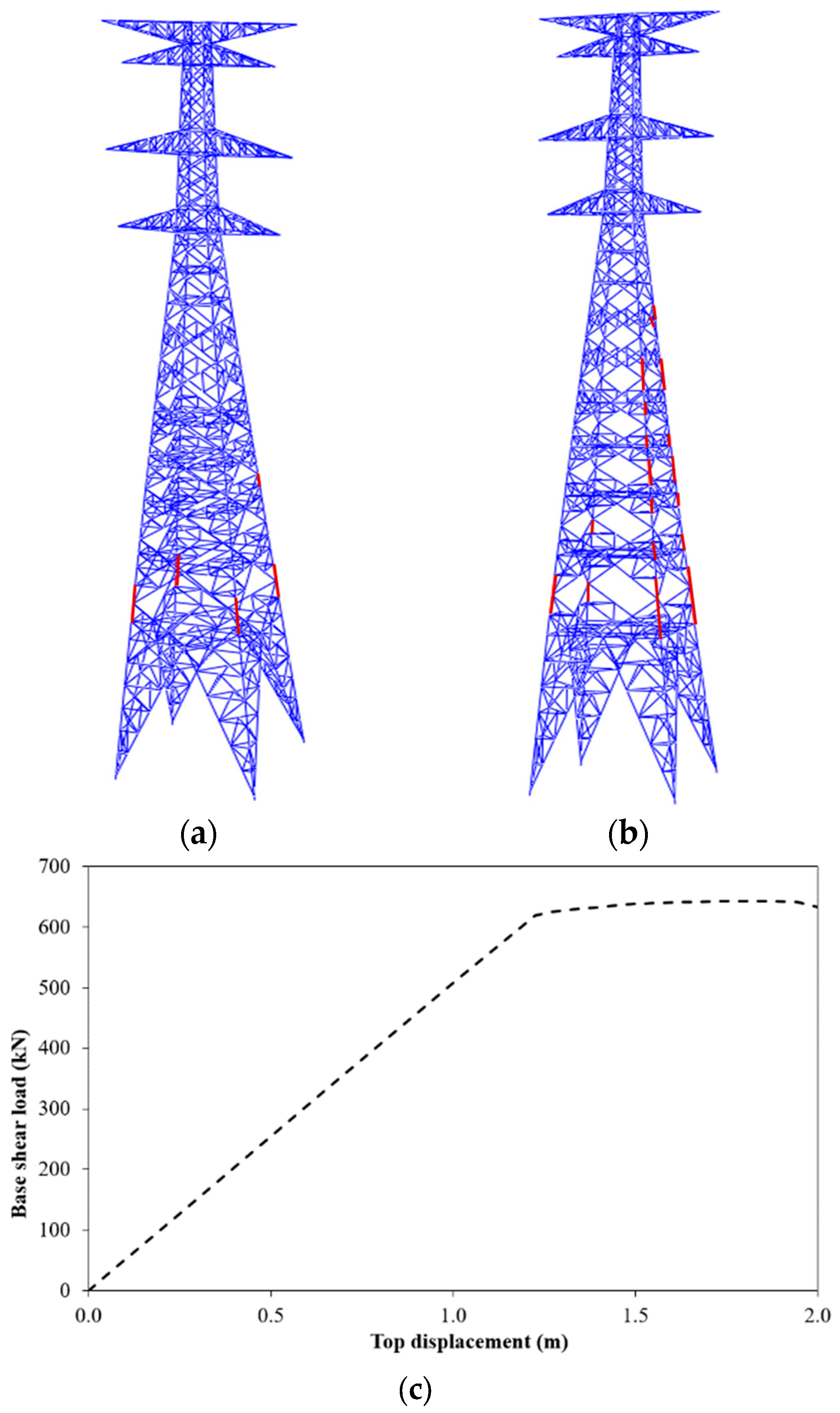
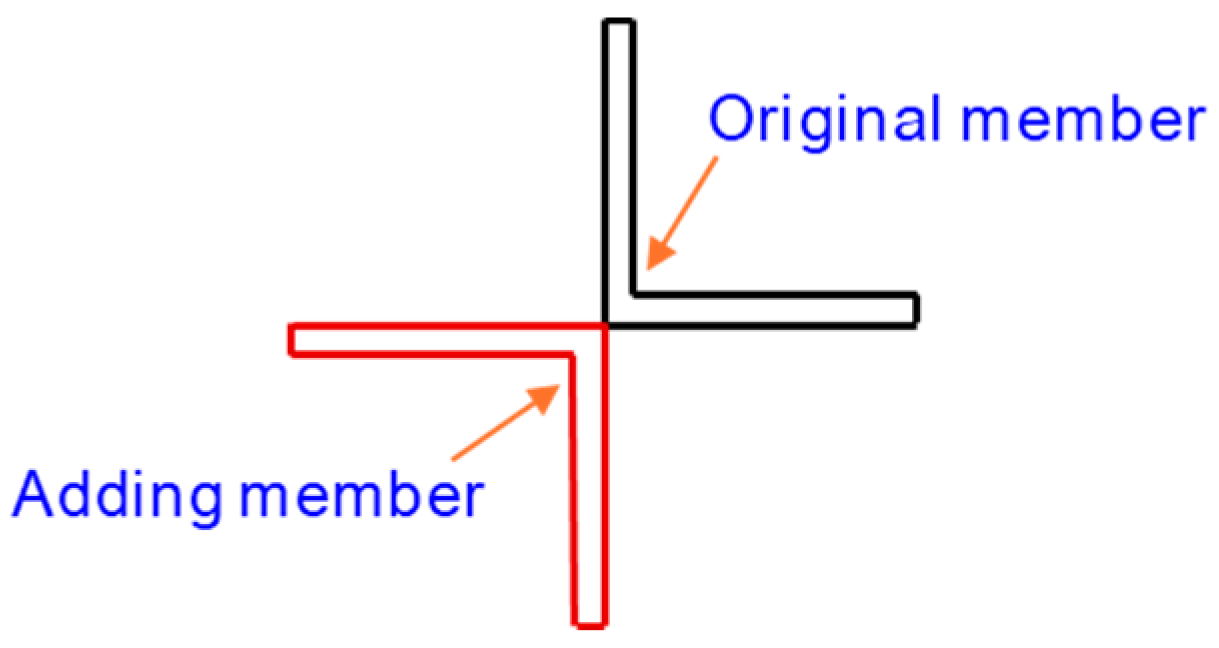


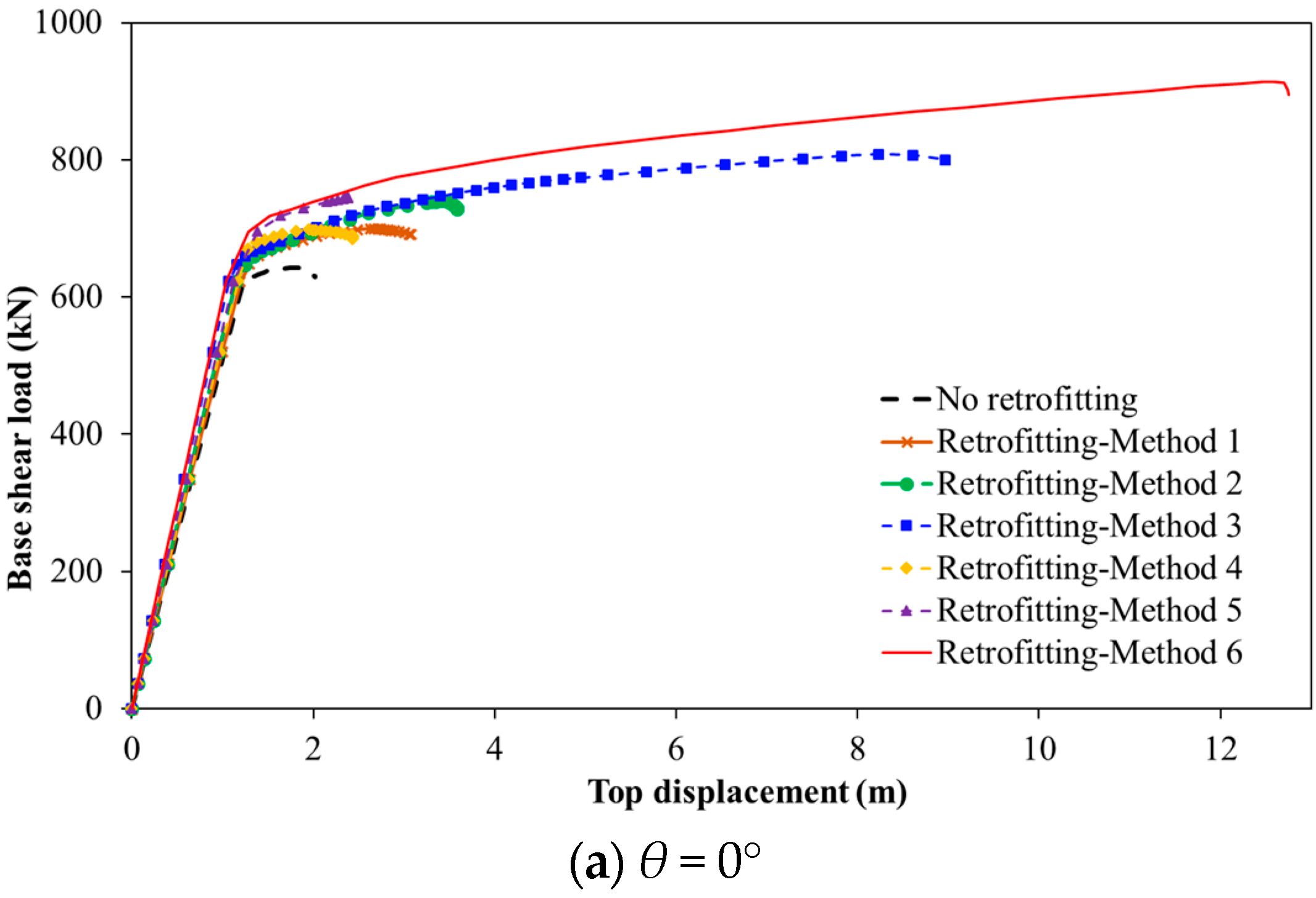

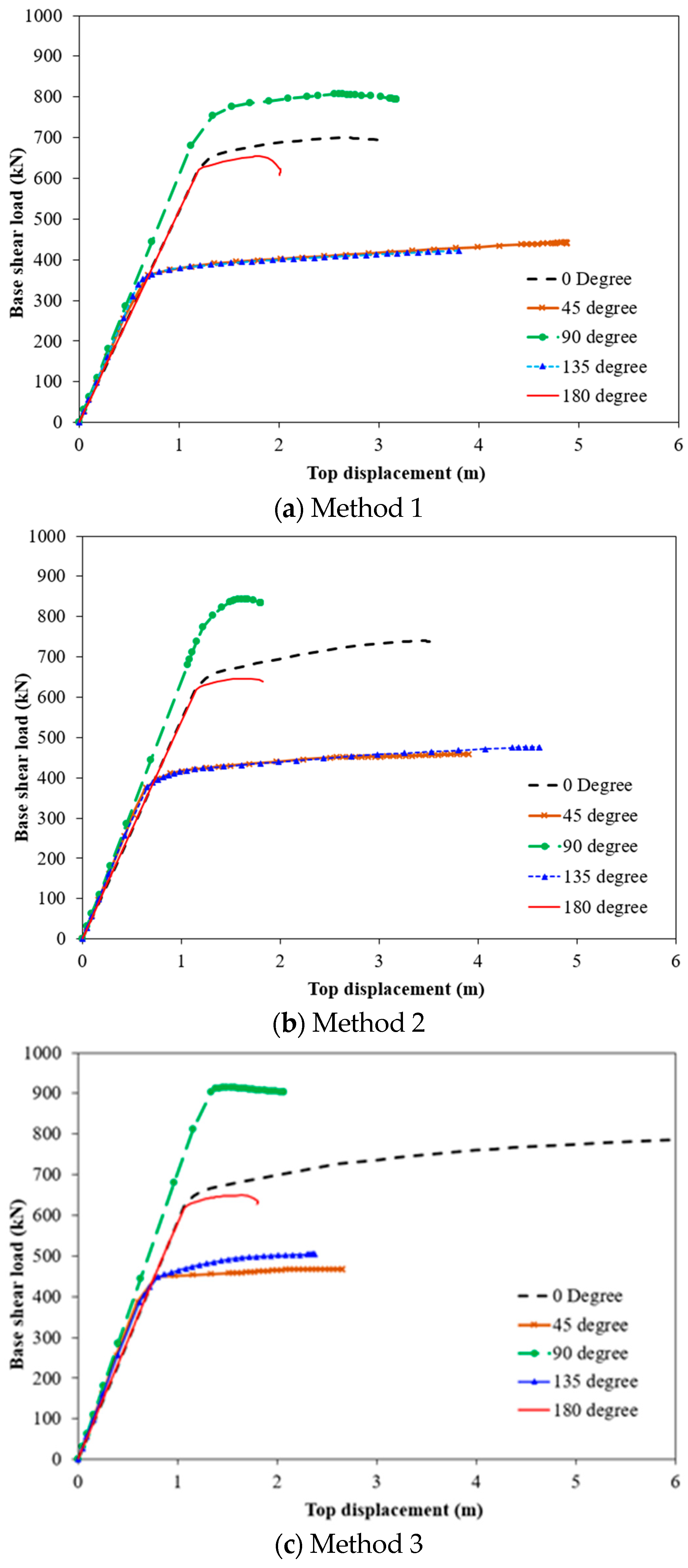
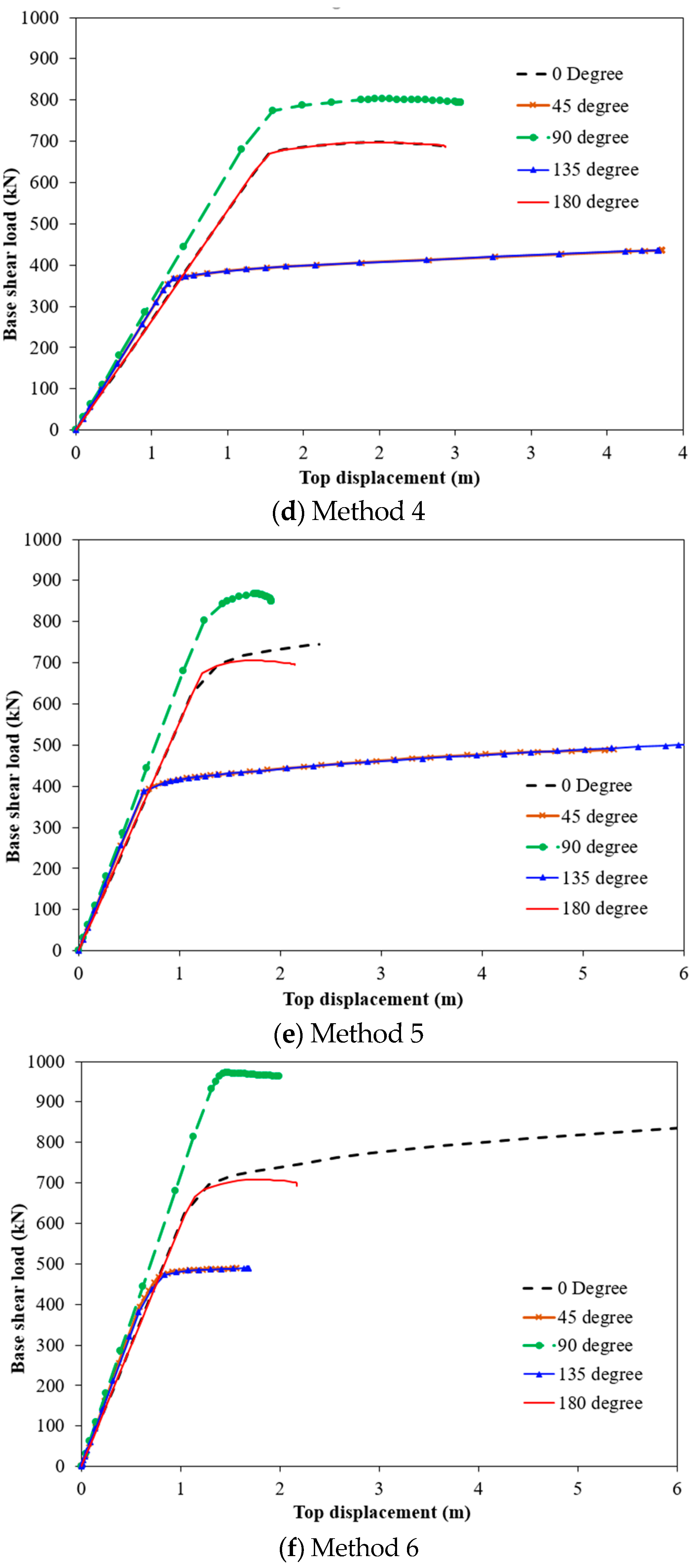

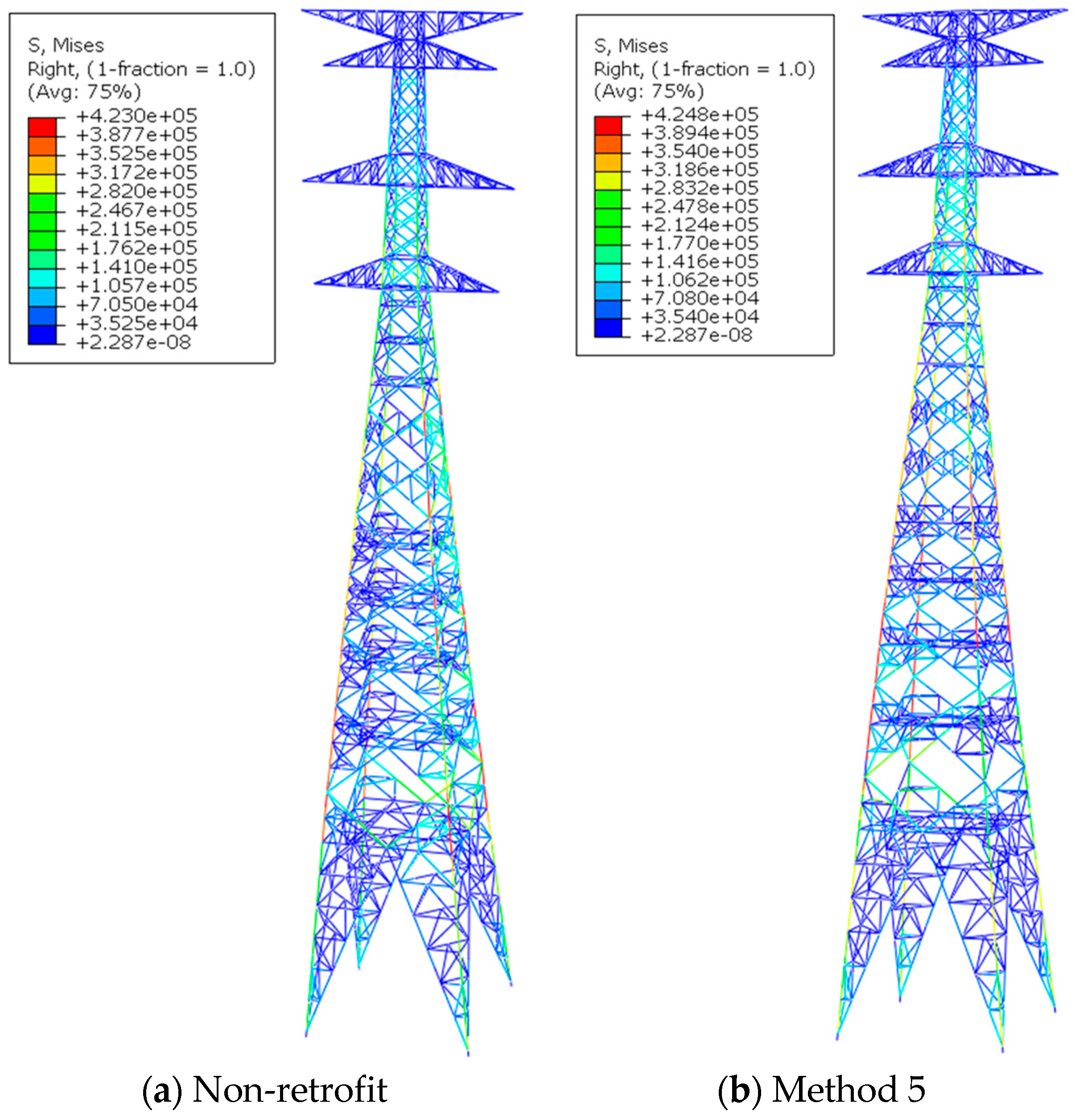
| Tower Members | Section Dimensions (mm) | Yield Strength (MPa) | Ultimate Strength (MPa) |
|---|---|---|---|
| Main leg 1 | 140 × 14 | 410 | 540 |
| Main leg 2 | 120 × 10 | 410 | 540 |
| Main cage | 100 × 8 | 410 | 540 |
| Main cross-arms | 90 × 8 | 250 | 400 |
| Horizontal braced members | 80 × 7 | 250 | 400 |
| Other members | 50 × 5 | 250 | 400 |
| Parameters | Unit | Conductor (2xLGJ-400/35) | Ground Wire (JLB20A-150) |
|---|---|---|---|
| Cross-section area | mm2 | 425.24 | 148.07 |
| Diameter | mm | 26.82 | 15.75 |
| Density | kg/m | 1.349 | 0.9894 |
| Maximum tension | kN | 78.96 | 37.70 |
| Breaking tension | % | 25 | 100 |
| Retrofitted Method | Maximum Base Shear Force (kN) | Difference (%) | ||||||||
|---|---|---|---|---|---|---|---|---|---|---|
| θ = 0° | θ = 45° | θ = 90° | θ = 135° | θ = 180° | θ = 0° | θ = 45° | θ = 90° | θ = 135° | θ = 180° | |
| No retrofit | 642.8 | 394.7 | 727.4 | 394.7 | 642.8 | |||||
| Method 1 | 699.9 | 441.5 | 806.7 | 410.1 | 655.3 | 8.9 | 11.9 | 10.9 | 3.9 | 2.0 |
| Method 2 | 740.5 | 459.2 | 843.3 | 476.2 | 646.2 | 15.2 | 16.4 | 15.5 | 20.7 | 0.5 |
| Method 3 | 808.3 | 468.3 | 914.0 | 503.7 | 649.0 | 25.8 | 18.6 | 25.6 | 27.6 | 1.0 |
| Method 4 | 698.0 | 436.1 | 802.0 | 436.1 | 698.0 | 8.6 | 10.5 | 10.2 | 10.5 | 8.6 |
| Method 5 | 744.6 | 488.7 | 866.9 | 500.8 | 705.9 | 15.8 | 23.8 | 19.2 | 26.9 | 9.8 |
| Method 6 | 914.2 | 489.1 | 971.4 | 489.3 | 708.8 | 42.2 | 23.9 | 33.5 | 24.0 | 10.3 |
Disclaimer/Publisher’s Note: The statements, opinions and data contained in all publications are solely those of the individual author(s) and contributor(s) and not of MDPI and/or the editor(s). MDPI and/or the editor(s) disclaim responsibility for any injury to people or property resulting from any ideas, methods, instructions or products referred to in the content. |
© 2025 by the authors. Licensee MDPI, Basel, Switzerland. This article is an open access article distributed under the terms and conditions of the Creative Commons Attribution (CC BY) license (https://creativecommons.org/licenses/by/4.0/).
Share and Cite
Vu, Q.-V.; Lee, H.-J.; Kim, J.-M. Nonlinear Pushover Analysis of Retrofitted Transmission Towers Under Static Wind Loads. Buildings 2025, 15, 654. https://doi.org/10.3390/buildings15050654
Vu Q-V, Lee H-J, Kim J-M. Nonlinear Pushover Analysis of Retrofitted Transmission Towers Under Static Wind Loads. Buildings. 2025; 15(5):654. https://doi.org/10.3390/buildings15050654
Chicago/Turabian StyleVu, Quang-Viet, Hyeok-Ju Lee, and Jae-Min Kim. 2025. "Nonlinear Pushover Analysis of Retrofitted Transmission Towers Under Static Wind Loads" Buildings 15, no. 5: 654. https://doi.org/10.3390/buildings15050654
APA StyleVu, Q.-V., Lee, H.-J., & Kim, J.-M. (2025). Nonlinear Pushover Analysis of Retrofitted Transmission Towers Under Static Wind Loads. Buildings, 15(5), 654. https://doi.org/10.3390/buildings15050654






